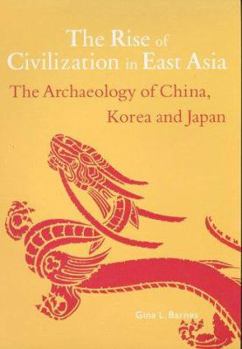The Rise of Civilization in the East: The Archaeology of China, Korea and Japan
Civilization in East Asia is nearly 4000 years old, and its origins lie deep in the prehistoric past. This volume charts the developments that culminated in the emergence of the region in the 8th... This description may be from another edition of this product.
Format:Paperback
Language:English
ISBN:0500279748
ISBN13:9780500279748
Release Date:July 1999
Publisher:Thames & Hudson
Length:288 Pages
Weight:1.55 lbs.
Dimensions:1.1" x 7.0" x 10.1"
Customer Reviews
1 rating
A decent though limited introduction to a complex subject
Published by Thriftbooks.com User , 23 years ago
My hat is off to Gina Barnes for undertaking a phenomenally difficult task. The archaeology of China, Korea and Japan from 11,000 BC to 600 AD covers a stupendous time range and an equally stupendous geographic and cultural range.This book is a very useful summary of the archaeological highlights in three very different areas together with a number of useful (though brief) discussions of some of the important theoretical and political issues involved. Her treatments of the overall trajectories of cultural development in East Asia are interesting and thought-provoking and for students who want to gain a "feel" for East Asian archaeology and the "deep past" of China, Korea, and Japan, this book is a very good start.Perhaps the most valuable contribution that Barnes makes (apart from the book's obvious appeal as a summary volume) is her attempt to get East Asianists to think beyond national boundaries when looking at the archaeological evidence. While Japan and Korea are not my areas of expertise, it seems to me that her discussion of the Pen/Insular region especially during the period from 300 BC - 600 AD (roughly corresponding to the Yayoi and Kofun periods in Japan and the Late Bronze and Early Iron Ages in Korea) is the best example of the strengths of an integrated "cultural sphere" approach.Another useful contribution (paradoxically perhaps) of the book is her demonstration that simplistic notions of "Asian" homogeneity cannot be supported by the archaeological evidence. In fact, as the contents of the book itself makes fairly clear, there is very little unity even within any of the specific national regions until (perhaps) the very end of the period covered by the book. What Barnes illustrates nicely is that there were important geographical and cultural sub-regions which played key roles in the development of "civilization" in each of the areas covered by the modern nations of China, Japan and Korea. In some situations, these sub-regions were clearly in contact with other places far distant from them, often in very important ways. However, the local contexts of each of these sub-regions was just as important as any links with distant cultures or people.Despite these obvious strengths, there are also a number of reasons why I would hesitate to recommend this book for more specialized courses in East Asian archaeology and why I think people who use this book to teach courses on "East Asian" anything need to be a little wary. Firstly, as Barnes makes very clear herself, this is a summary volume in the absolute sense. Crucial topics in East Asian archaeology (especially the origins of agriculture and the sections on the Jomon culture of Japan and the Shang dynasty in China) are handled very very cursorily and even the (fairly comprehensive) suggested reading section does not really compensate for this.Secondly, and again this is a function of this book's primary purpose as a "layperson's introduction" to East Asian archaeology, important





